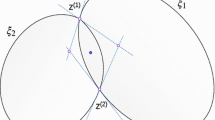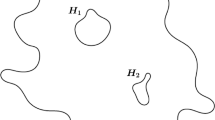Abstract
In this paper, we have presented a new method for computing the best-fitted rectangle for closed regions using their boundary points. The vertices of the best-fitted rectangle are computed using a bisection method starting with the upper-estimated rectangle and the under-estimated rectangle. The vertices of the upper- and under-estimated rectangles are directly computed using closed-form solutions by solving for pairs of straight lines. Starting with these two rectangles, we solve for the best-fitted rectangle iteratively using a bisection method. The algorithm stops when the areas of the fitted rectangles remain unchanged during consecutive iterations. Extensive evaluation of our algorithm demonstrates its effectiveness.
Similar content being viewed by others
References
Rosin P.L.: Measuring shape: ellipticity, rectangularity and triangularity. Mach. Vis. Appl. 14, 172–184 (2003)
Dondis D.: A Primer of Visual Literacy. MIT Press, Cambridge (1973)
Hilderbrandt S., Tromba A.: Mathematics and Optimal Form. Scientific American Library, St. Louis (1985)
Hyde S.T., Andersson S., Blum Z., Lidin S., Larsson K., Landh T., Ninham B.W.: The Language of Shape. Elsevier, Amsterdam (1997)
Gonzalez R.C., Woods R.E.: Digital Image Processing. Pearson Education, Asia (2001)
Sonka M., Hlavac V., Boyle R.: Image Processing, Analysis and Machine Vision, pp. 77–83. International Thomson Publishing Company, New York (1999)
Nakagawa Y., Rosenfeld A.: A note on polygonal and elliptical approximation of mechanical parts. Pattern Recognit. 11, 133–142 (1979)
Sychra J.J., Bartels P.H., Tayler J., Bibbo M., Weld G.L.: Cytoplasmic and nuclear shape analysis for computerized cell recognition. Acta. Cytol. 20, 68–78 (1976)
Ellis, T.J.: Morphometric measurements in biomedical microscopy using boundary analysis, Ph. D. thesis, London University, London (1982)
Chaudhuri D.: A simple least squares method for fitting of ellipse and circles depends on border points of a two-tone image and their 3-D extensions. Pattern Recognit. Lett. 31, 818–829 (2010)
Bookstein F.: Fitting conic sections to scattered data. Comput Graph. Image Process. 9, 56–71 (1979)
Forsyth D. et al.: Invariant descriptors for 3-D object recognition and pose. IEEE Trans. PAMI 13, 971–991 (1991)
Rosin P.L.: A note on least square fitting of ellipses. Pattern Recognit. Lett. 14, 799–808 (1993)
Werman M., Keren D.: A Bayesian method for fitting parametric and non-parametric models to noisy data. IEEE Trans. PAMI. 23(5), 528–534 (2001)
Alt, H., Hurtado, F.: Packing convex polygons into rectangle boxes, In: Discrete and Computational Geometry—Japanese Conference, JCDCG. 2098, Lecture Notes in Computer Science, pp. 67–80. Springer, Berlin (2001)
Kreveld, M.V., Speckmann, B.: Cutting a country for smallest square fit, In: Bose, P., Morin, P., (Eds.), ISAAC, Lecture Notes in Computer Science, vol. 2518, pp. 91–102. Springer, Berlin (2002)
Suesse, H., Voss, K.: A new efficient algorithm for fitting of rectangles and squares, IEEE, pp. 809–812 (2001). http://Pandora.inf.uni-jena.de/papers/icip_2127.pdf
Chaudhuri D., Samal A.: A simple method for fitting of bounding rectangle to closed regions. Pattern Recognit. 40, 1981–1989 (2007)
Haralick R.M.: A measure of circularity of digital figures.. IEEE Trans. SMC 4, 394–396 (1974)
Belson M., Dudley A.W., Ledley R.S.: Automatic computer measurements of neurons. Pattern Recognit. 1, 119–128 (1968)
Proffitt D.: The measurement of circularity and ellipticity on a digital grid. Pattern Recognit. 15(5), 383–387 (1982)
Proffitt D.: Normalization of discrete planar objects. Pattern Recognit. 15, 137–145 (1982)
Chaudhuri D.: Object area-based method for elliptic and circular fit of a two-tone image. Def. Sci. J. 58(6), 710–714 (2008)
Chaudhuri D., Agrawal A.: A new split-and-merge segmentation technique by using bimodality detection approach. Def. Sci. J. 60(3), 290–301 (2010)
Gander W., Golub G.H., Strebel R.: Least squares fitting of circles and ellipses. BIT 34, 558–578 (1994)
Watson G.A.: Least squares fitting of parametric surfaces to measured data. ANZIAM J. 42(E), C68–C95 (2000)
Parui S. K., Dutta Majumder D.: A new definition of shape similarity. Pattern Recognit. Lett. 1, 37–42 (1982)
Author information
Authors and Affiliations
Corresponding author
Rights and permissions
About this article
Cite this article
Chaudhuri, D., Kushwaha, N.K., Sharif, I. et al. Finding best-fitted rectangle for regions using a bisection method. Machine Vision and Applications 23, 1263–1271 (2012). https://doi.org/10.1007/s00138-011-0348-6
Received:
Revised:
Accepted:
Published:
Issue Date:
DOI: https://doi.org/10.1007/s00138-011-0348-6




